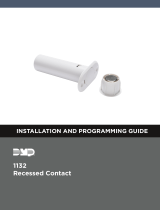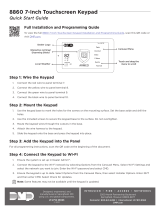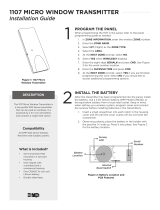Page is loading ...

1107 MICRO WINDOW
TRANSMITTER
Installation Guide
Figure 1: 1107 Micro Window Transmitter
The 1107 Micro Window Transmitter is a
low‑profile 1100Series transmitter that
can be used on windows. It is powered
by a 3V coin cell battery and contains a
single reed switch.
Compatibility
All DMP XT Series and XR Series and
1100 Series Wireless Receivers
What is Included?
• 1107 Transmitter PCB Mounted in a
Two‑Part Housing
• One Magnet with a Standard and a
Commercial Housing
• One CR2430 3V Coin Cell Lithium
Battery
• Double‑sided Tape
1PROGRAM THE PANEL
When programming the 1107 in the panel, refer to the
panel programming guide as needed.
1. In ZONE INFORMATION, enter the wireless
ZONE NO: and press CMD.
2. Enter the ZONE NAME and press CMD.
3. Select NT (Night) as the ZONE TYPE.
4. Select the AREA.
5. At the NEXT ZONE prompt, select NO.
6. Select YES when WIRELESS? displays.
7. Enter the eight‑digit SERIAL# and press CMD.
See Figure2 for the serial number location.
8. Enter the SUPRVSN TIME and press CMD.
9. At the NEXT ZONE prompt, select YES if you
are finished programming the zone. Select NO if
you would like to access additional programing
options.
DESCRIPTION 2INSTALL THE BATTERY
After the transmitter has been programmed into the
panel, install the battery. Use a 3V lithium battery,
Sony CR2430, or equivalent battery from a local
retail outlet. Keep in mind, when setting up a wireless
system, program zones and connect the receiver
before installing batteries in the transmitter.
1. Insert a small screwdriver into each notch in the
housing cover and lift until the cover comes o.
Do not twist the screwdriver.
2. Observing polarity, place the battery in the
holder with the positive (+) side up. Press it into
place. See Figure2 for the battery location.
Figure 2: Battery Location and PCB Features
Battery
Location
Survey LED
Serial
Number
Internal Reed
Switch

2 1107 INSTALLATION GUIDE | DIGITAL MONITORING PRODUCTS
3SELECT A LOCATION
4MOUNT THE 1107 TRANSMITTER
The 1107 provides a survey capability to allow one person to confirm communication with the
wireless receiver or panel while the cover is removed.
1. Hold the 1107 transmitter and the included magnet in the exact desired location.
2. Move the magnet away from the transmitter to send data to the receiver and determine if
communication is confirmed or faulty. See Figure 2 for LED locations.
Confirmed: If communication is confirmed, for each transmission the LED blinks
immediately on and immediately off. Repeat this test to confirm five separate
consecutive LED blinks. Any indication otherwise means proper communication has
not been established.
Faulty: If communication is faulty, the LED remains on for about 8 seconds or flashes
multiple times in quick succession. Relocate the 1107 or wireless receiver until the LED
confirms clear communication.
3. Relocate the 1107 or receiver until the LED confirms clear communication. Proper
communication between the 1107 and receiver is verified when the LED blinks immediately
on and immediately o each time the magnet is removed.
The transmitter and magnet assembly should have
no more than 1/2” between the assembled housings
after installation. When mounting on metal (ferrous)
surfaces, this distance is slightly less. DMP recommends
mounting the transmitter on the window frame and the
magnet assembly on the window.
1. Hold the transmitter base in place with the reed
switch alignment marker near where the magnet
assembly will be mounted. See How to Align the
Transmitter and Magnet Assembly for more
information.
Note: Do not remove the PCB from the
housing during installation.
2. Place the two supplied #4 flat‑head screws into
the mounting holes to secure the housing base to
the surface. See Figure3.
3. Replace the cover.
For environments where the cover could be dislodged,
use the optional #4 pan‑head securing screw instead of
the center flat‑head screw to secure the transmitter and
cover to the mounting surface. See Figure3.
For even quicker installations, use the included
double‑sided tape instead of the screws to attach the
housing to the mounting surface.
Figure 3: Mounting
Hole Locations
Pan-Head Securing
Screw (optional)
Flat-Head
Mounting Screws
HOW TO ALIGN THE TRANSMITTER AND MAGNET ASSEMBLY
When you mount the transmitter
and magnet assembly, use the
alignment markers to ensure that
the transmitter’s internal reed
switch is lined up with the magnet.
There should be no more than
a 1/2” inch of space between
the transmitter and the magnet
assembly.
Alignment
Markers
1/2” Max
Distance

1107 INSTALLATION GUIDE | DIGITAL MONITORING PRODUCTS 3
Only one magnet assembly is required for internal reed switch
operation. Depending on the installation requirements, you
can use either the standard or commercial magnet assembly.
Standard Magnet Assembly
1. Place the magnet assembly base on the surface nearest
the transmitter’s internal reed switch location. Be sure
to align the markers on the transmitter and magnet
assembly.
2. Use the provided #4 flat‑head screws or included
double‑sided tape to secure the base in place.
3. Snap the magnet into the magnet assembly cover, then
snap the cover onto the base.
Commercial Magnet Assembly
1. Snap the magnet into the magnet assembly cover.
2. Place the cover on the surface nearest to the internal
reed switch location. Be sure to align the markers on the
transmitter and magnet assembly.
3. Use the supplied #4 flat‑head screws to mount the
magnet assembly. See Figure 5.
MOUNT THE MAGNET ASSEMBLY
5
Figure 4: Standard
Magnet Assembly
Magnet
Cover
Base
Figure 5: Commercial
Magnet Assembly
Magnet
Cover
REPLACE THE BATTERY
1. Insert a small screwdriver into the notch in the housing cover and lift until the cover comes o. Do not
twist the screwdriver.
2. Remove the old battery and dispose of it properly.
3. Observing polarity, place the new battery in the holder and press into place.
4. Snap the transmitter housing cover back on the base.
Caution: Properly dispose of used batteries. Do not recharge, disassemble, heat above 212°F (100°C),
or incinerate. Risk of fire, explosion, and burns.
Sensor Reset to Clear LOBAT
When the battery needs to be replaced, a LOBAT message will display on the keypad. Once the battery is
replaced, a sensor reset is required at the system keypad to clear the LOBAT message.
1. On a Thinline keypad, press and hold “2” for two seconds. On a touchscreen keypad press RESET.
2. Enter your user code if required.
3. The keypad displays SENSORS OFF followed by SENSORS ON.
After installing the 1107, perform a Wireless Check‑in Test to confirm the 1107 is communicating
with the panel. At the keypad, enter 8144 (WALK) and select WLS. If the 1107 fails to check in at
the keypad, relocate the wireless device, receiver, or panel.
TEST THE 1107
6

Designed, engineered, and
manufactured in Springfield, MO
using U.S. and global components.
LT-1156 21203
INTRUSION • FIRE • ACCESS • NETWORKS
2500 North Partnership Boulevard
Springfield, Missouri 65803-8877
800.641.4282 | DMP.com
Patents
U. S. Patent No. 7,239,236
Certifications
FCC Part 15 Registration ID CCKPC0133
IC Registration ID 5251A‑PC0133
1107 MICRO WINDOW
TRANSMITTER
Specifications
Battery
Life Expectancy 2 years
Type 3V Lithium CR2430
Frequency Range 905‑927 MHz
Dimensions
Transmitter 2.625” L x 1” W x .3125” H
Standard Mag. 2.125” L x .375” W x .3125” H
Commercial Mag. 2.125” L x .375” W x .3125” H
Color White
Housing Material Flame retardant ABS
FCC INFORMATION
This device complies with Part 15 of the FCC Rules. Operation is subject to the following two conditions:
1. This device may not cause harmful interference, and
2. this device must accept any interference received, including interference that may cause undesired operation.
The antenna used for this transmitter must be installed to provide a separation distance of at least 20 cm (7.874 in.) from
all persons. It must not be located or operated in conjunction with any other antenna or transmitter.
Changes or modifications made by the user and not expressly approved by the party responsible for compliance could
void the user’s authority to operate the equipment.
Note: This equipment has been tested and found to comply with the limits for a Class B digital device, pursuant to
part 15 of the FCC Rules. These limits are designed to provide reasonable protection against harmful interference in
a residential installation. This equipment generates, uses and can radiate radio frequency energy and, if not installed and
used in accordance with the instructions, may cause harmful interference to radio communications. However, there is no
guarantee that interference will not occur in a particular installation. If this equipment does cause harmful interference to
radio or television reception, which can be determined by turning the equipment off and on, the user is encouraged to
try to correct the interference by one or more of the following measures:
1. Reorient or relocate the receiving antenna.
2. Increase the separation between the equipment and receiver.
3. Connect the equipment into an outlet on a circuit dierent from that to which the receiver is connected.
4. Consult the dealer or an experienced radio/TV technician for help.
Industry Canada Information
This device complies with Industry Canada Licence‑exempt RSS standard(s). Subject to the following two conditions:
1. This device may not cause interference, and
2. this device must accept any interference, including interference that may cause undesired operation of the device.
This system has been evaluated for RF Exposure per RSS‑102 and is in compliance with the limits specified by Health
Canada Safety Code 6. The system must be installed at a minimum separation distance from the antenna to a general
bystander of 7.87 inches (20 cm) to maintain compliance with the General Population limits.
Le présent appareil est conforme aux CNR d’Industrie Canada applicables aux appareils radio exempts de licence.
L’exploitation est autorisée aux deux conditions suivantes:
1. l’appareil ne doit pas produire de brouillage, et
2. l’utilisateur de l’appareil doit accepter tout brouillage radioélectrique subi, même si le brouillage est susceptible
d’en compromettre le fonctionnement.
L’exposition aux radiofréquences de ce système a été évaluée selon la norme RSS-102 et est jugée conforme aux limites
établies par le Code de sécurité 6 de Santé Canada. Le système doit être installé à une distance minimale de 7.87 pouces
(20 cm) séparant l’antenne d’une personne présente en conformité avec les limites permises d’exposition du grand
public.
/
















